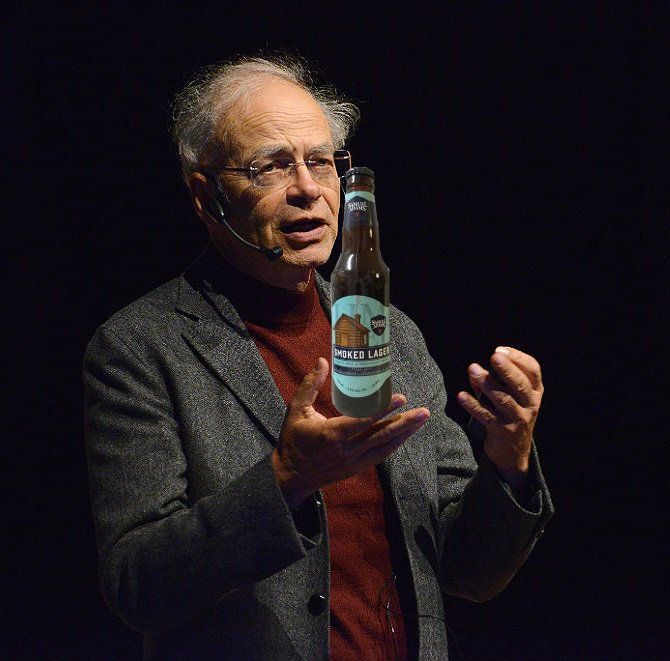A couple months ago I wandered lonely as a cloud through my local grocer's liquor store and came upon Sam Adams' American Craft Lagers Variety Pack. As a lover of lagers it was quite refreshing to see an assemblage of beers that had been given a generous amount of time to age, weren't barrel aged, nor described as "juicy" yet had a plethora of flavors on offer. Many breweries whose stock-in-trade is the IPA throw in a pils or unleash an Oktoberfest in the autumn seemingly to demonstrate that they are not some one trick pony but lagers generally don't get a lot of love. And, truth be told, a lot of these black sheep of the brewery lagers are just not very good.
The variety pack was lead by Sam Adams' flagship Boston Lager. Filling in the ranks were Noble Pils, Fresh as Helles (a helles with orange blossom), Coffee Black Lager, Kellerbier, and Smoked Lager. The last one was especially pleasing to find as smoke beers are close to my liver and like the Brigadoon of the brewing world. Not only was I blessed with a plethora of lagers but my purchase entitled me to a free ham. You don't get porcine lagniappes with those trendy hazy eyepahs.
One notable aspect of the variety pack that didn't occur to me until I got it home was how utilitarian the names are. (Did Peter Singer do the labels and marketing?) "Smoked Lager", "Coffee Black Lager" – not even "Al's Smoked Lager". If someone ever remakes Repo Man for the craft beer age, they will surely hire whoever came up with these names as production designer.
And the labels. They are moderately spartan with an image against a mostly solid background. Other beers get a scantily clad woman who adheres to conventional conceptions of beauty or a pistol-wielding cat riding a unicorn. Here the Kellerbier label has a rendering of what appears to be Delicate Arch out in Utah. Huh? On the other hand, the Fresh as Helles label has an appropriate Pantone shade of orange and I must admit to liking the absurdity of a bear holding a coffee cup on the Coffee Black Lager label. If only it was extending it ursine equivalent of a pinkie finger. Overall, though, the look of this variety pack just feels thrown together.
But what's truly important is what lies beneath the label and behind the glass when the lip of the bottle is between my lips.
Smoked Lager is a lovely deep amber hue and quite clear. My initial pour produced a rather small tan head although my subsequent attempt at getting the beer in my glass provided a much more generous topping of foam which was more befitting of a fine lager. Inside there was a lot of bubbles which, again, pleased the aesthete in me.
I was surprised by just how sweet the beer smelled. Some caramel, some stone fruit. The smoky scent registered as medium on my highly unscientific syringolic scale but was oh so nice. To round things out was a touch of grassy hops.
Thankfully Smoked Lager proved to not actually taste particularly sweet and the honeyed aroma belied a light-medium body. While there was some sweetness there, the rich smokiness stepped forward. It was paired with a gentle bread flavor as toasty and earthy tastes hovered in the background. A dash of peppery hops and generous fizz added to the crisp lagery goodness.
The finish was dryer than I expected and more bitter as well. Again, it was the fizz and spicy hops. But some smoke lingered as well. Schaumhaftvermoegen levels were at Defcon 3 with several streaks of foam lining my mug.
This is a very good beer. Bamberg, Germany's Schlekerla is the standard bearer for smoked lagers even if only because theirs are most commonly found on store shelves here with the other brewers in Bamberg choosing to keep things local, generally speaking. Sam Adams' take on the style isn't as smoky as Schlenkerla's but by no means is it merely an accent. To the fore yet still something that an open-minded non-rauchbier drinker wouldn't immediately flee from in terror. The smoked malt was done so using beech wood. This variety is very common though I am not sure why. Perhaps an Old World legacy?
The one thing that didn't thrill me about Smoked Lager was the carbonation. A tad too much fizz. It gave the brew a sharpness that detracted from the smoke whose mellow richness should be allowed to shine. But this isn't a fatal blow.
Junk food pairing: Presumably the free ham deal is over and has moved on to pretzels or cheese. So pair your Smoked Lager with some Lay's Barbecue Ham or Kettle Brand's Maple Bacon potato chips.
And remember, smoke is the new haze in 2018!

